by Beth
And now, the long-awaited rooster crow!
He’s up to 4-5 syllables and crows from 6:05-6:20. He doesn’t wake us or the dogs. I’ve been told he may get louder, though Brahma roosters are supposed to be quiet in comparison to other kinds of chickens. If the wind is right, you can hear the neighbor’s screeching game roosters from a mile away by 5:30 a.m. and again in the late afternoon through sunset. Low-volume crows are one reason we ordered the rooster we did.
Well, actually we ordered a Buff Brahma rooster. Cogburn is a Light Brahma, which we didn’t realize until he was a couple weeks old and his feathers were growing in white. We’ve never known if the farmers co-op put in the wrong order or if the error happened at the hatchery. Until this week.
Hatcheries fulfill orders of thousands and thousands of chicks weekly. Errors are common. Chicks are fragile and inexpensive, so besides errors, it’s the norm for direct shipments of chicks from hatcheries to include a handful of “extras,” some of which may be roosters. If you’re a planner with limited space, it will be safest to pick your chicks out of the feed-store brooder instead of placing an order yourself. Or just open your mind to the unpredictability of chickens. But I digress.
Like many Light Brahmas, Cogburn has light tan/buff highlights on his wings, which got me thinking about another possibility: was there no error at all? Did he hatch out of a Buff Brahma egg and happen to turn white instead? Brahmas have a sex-linked gene that can make males in some hatches white (technically Cogburn’s color is called “silver” or “Columbian”) while females will be brown (“buff” in chicken speak).

As we learn more about chickens, and as egg-laying time approaches, my questions about Cogburn’s provenance have taken on new importance. Way back in January when we ordered a Buff Brahma rooster to go with our Buff Brahma hens, we just wanted a rooster to help protect the hens. We didn’t think about whether that rooster would be related to the pullets or that we may want to let our hens hatch their own chicks from time to time.
Some level of chicken inbreeding is technically acceptable, and common. But even if we were cool with that, it’s inadvisable to hatch the offspring of full siblings because of the amount of genes siblings share. Hence, I wanted to know if it was at all possible Cogburn is the brother of our Brahma pullets. Did he come from a hatch where girls were buff and boys were Columbian?
Short answer, almost certainly not, according to a representative at Ideal Poultry, where our farmers co-op orders chicks from. This is only the word of one person, but her answers made sense, and she offered helpful insights around how hatcheries work.
Our chat was longer than the following egg-cerpts, har har, but here’s the gist:
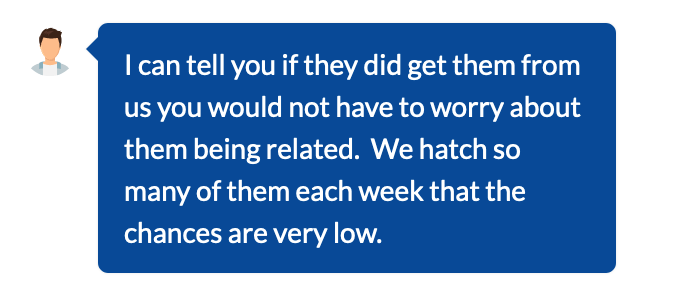
Hatcheries hatch more chicks than you’d even expect. They’re not letting a hen sit on her eggs and then carefully packing those chick families together. They’re snagging eggs as chickens lay them and dumping them in massive incubators, then grabbing chicks as they hatch and sending them off by the thousands each week.
She checked into why we ended up with a Light Brahma instead of a Buff Brahma rooster, too, though I didn’t ask her to. I was fine not knowing who made the mistake as long as I knew Cogburn and his Brahma hens – as well as the accidental Easter Egger cockerel and his ladies – didn’t hatch from the same parents. It was the hatchery’s mistake. When I asked her about the possibility of a sex-linked hatch where a Light and Buff Brahma may have mixed, she said this:
When I asked her about the possibility of a sex-linked hatch where a Light and Buff Brahma may have mixed, she said this: I’m pretty sure different breeds, like Light and Buff Brahmas, don’t get to mingle in a commercial hatchery. Hatchery staff moves fast to ship chicks within a certain window, and a lot of breeds look alike as day-old chicks, so it’s certainly easy to grab the wrong one. I’m sure she would’ve refunded my $2.50 if I’d really pressed the issue; besides errors, hatcheries are known for excellent customer service.
I’m pretty sure different breeds, like Light and Buff Brahmas, don’t get to mingle in a commercial hatchery. Hatchery staff moves fast to ship chicks within a certain window, and a lot of breeds look alike as day-old chicks, so it’s certainly easy to grab the wrong one. I’m sure she would’ve refunded my $2.50 if I’d really pressed the issue; besides errors, hatcheries are known for excellent customer service.
I appreciated their candor about ol’ Cogburn. We wish he were more camouflaged for safety against aerial predators. Of course, if he keeps growing, it won’t matter.
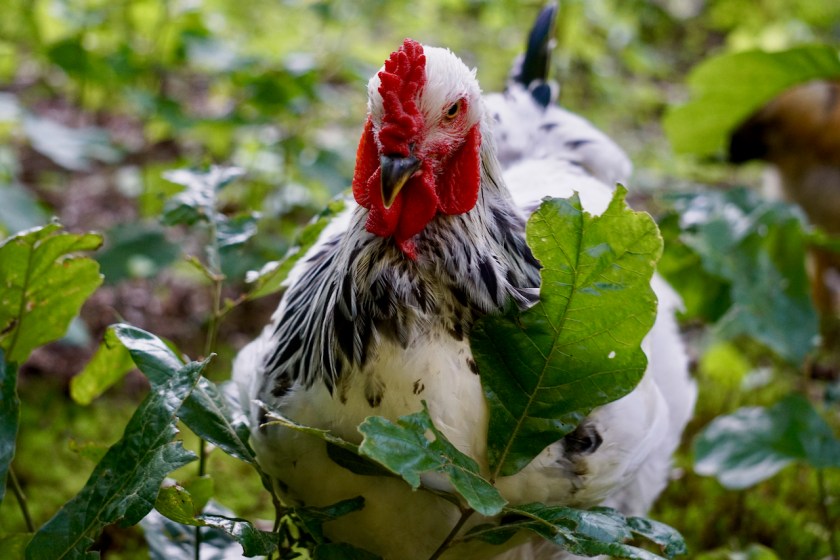
He’s been pretty calm with the pullets and me this week, but he’s still a baby. I have a feeling he’ll be going through different phases over the next few months.
One instance where he still consistently bullies the pullets is when herding them away from a threat like a squirrel or extra big butterfly. Meanwhile, he seems confused about how he’s supposed to react to the large black snake that keeps appearing in the run.
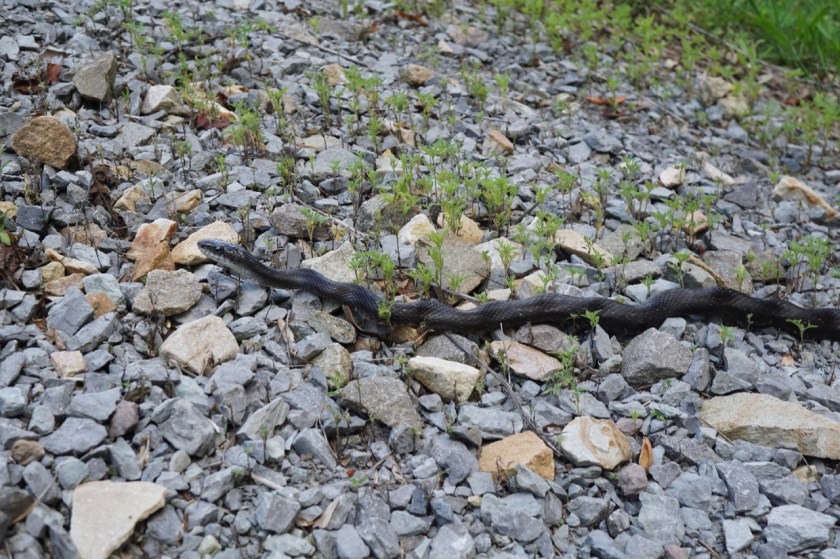
The snake is probably there for the mice around their spilled feed. That’s good, but it just kept showing up. It could easily bite a chicken, dog, or human who stepped on it. The real kicker: sometimes black snakes kill hens. At 4′ long, it wouldn’t be able to eat a chicken and probably wouldn’t try, but apparently it’s a possibility.
It doesn’t help that this snake isn’t afraid of anything.
I was handfeeding the chickens one afternoon to keep up chicken-human relations, when Donna wandered off instead of hopping on my shoulder. Suddenly, she was slow-motion peeping, staring at the ground. The snake was stretched out, staring back. It didn’t seem to consider leaving until I walked up and started clapping at it.
Luckily it wasn’t in the mood to coil and strike any of the 3 times this played out in the span of 36 hours, once more with Donna – she’s head hen and takes the job seriously – and once with Cogburn. It did try to sink its fangs into the garbage bag we unsuccessfully corralled it toward.
This may be the same snake that crawled out of the seat onto Chris’ lap while he was trying to start Black Sunshine (farm truck) not far from the chicken run a few weeks ago. There are mice in that truck, too, which may be why it won’t start, so we like snakes, but this one needs to leave. Our poorly conceived plan to catch and rehome via garbage bag ended up harassing the snake away instead. We haven’t seen it since.
There are stories of people letting snakes live in their coops to control the mice and eat extra eggs. Because it’s common for people to set wooden eggs or golf balls in nesting boxes to encourage chickens to lay in the boxes, people also know that snakes eat those fake eggs. In case the snake is looking for eggs, I placed golf balls in the nesting boxes so it could fill up on those instead of attacking chickens.
Donna was first up in the coop that evening and appalled by the golf balls. She started to yell down the ramp, and Cogburn yelled back until finally Donna ran down the ramp and all the chickens started to lay down in the run, so some kind of complex conversation was happening there. I set the golf balls on the ground instead, and at some point they all wobbled up the ramp to give the coop another try.
I also aimed solar-powered motion-sensor alarms at the ground to catch snake movement. Snakes won’t care about their beeping, but the dogs do and will wake us. Do I think a snake’s going to kill our chickens? Not really, but a few small adjustments made it even less likely.
In the brooder, the Easter Eggers are growing fast and have changed from extremely quiet to extreme party animals.

They flap and fly and scratch and peep. They love “dustbathing” on the towel that covers the ottoman.
They’re more feathered and better fliers than the bigger chicks were at that age. By 9 days, the brown one with lambchops made it to the edge of the brooder bin. Shortly after, they were able to hop out but rarely choose to. They’re surprisingly precise flyers, regularly flying to my arm from pretty far away.
The exception is the smallest one, a little redhead. She’s social but skittish and a little scattered. The day before they turned 2 weeks, I walked out of the study when the brooder cover was off and came back in to find the birds laying quietly in the brooder. Three of the birds. The redhead was lying still behind the brooder, looking confused. I scooped her up and put her back in, and the party recommenced immediately. Now she flies to my arm and stays until I physically remove her.
Her new-found tameness may make it easier to photograph her soon. The others pose from time to time. Except for the accidental rooster (the light one), they still look like chipmunks. They aren’t named yet.


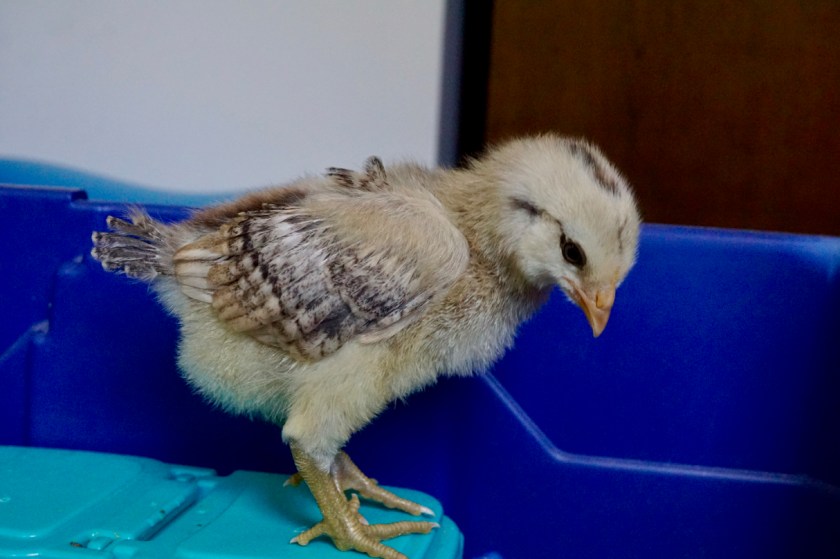
There’s been so much to do that these little birdies don’t get nearly as much attention as our first crew. Plus, they’re not as crowded in the brooder so are fine staying in there more. That’s good. Unlike the others who never left the area around the brooder bin, these go everywhere. If we’d had 7 of these in the house for 10 weeks instead of Langshans and Brahmas, we would’ve had to move out and give the chickens the house.
Because the Easter Eggers are so hardy and it’s so warm, I’ve already taken them outside. They didn’t take more than a few steps out of the safety of the cardboard box but were intrigued. They love to eat, so the grass was a hit.
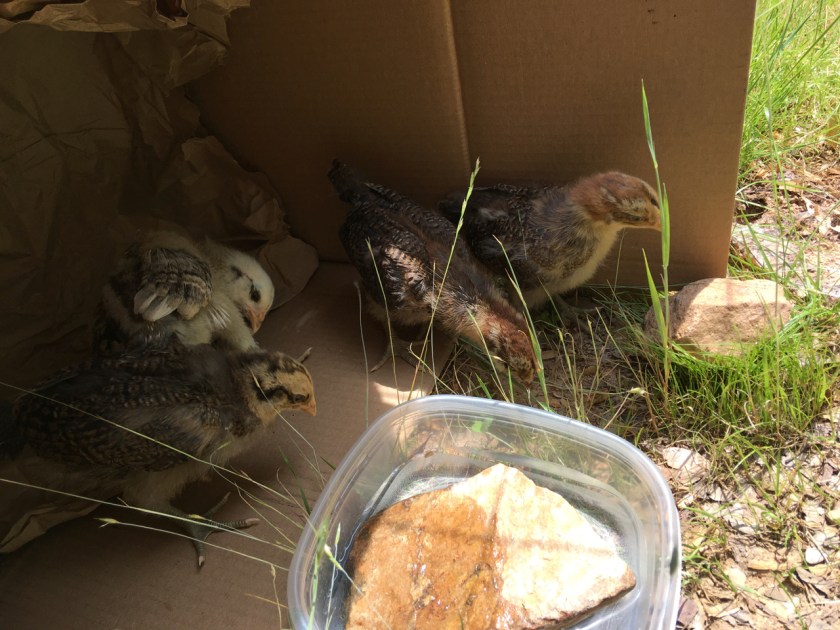
The chicks are now 14 weeks and 2 weeks old!


Those chicks are so cute.
LikeLike